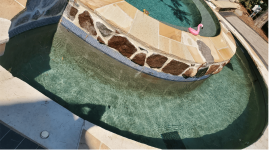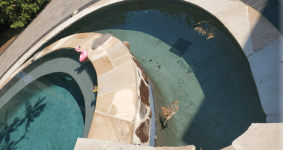Hopefully this isn't too difficult a conversation but I really need to understand the process here and why...
I have high iron content in my well, but I also have 4 massive iron filtering tanks in the basement of the house to help keep things iron free. (yes these are even hooked in line with my outside water spigots (to prevent the bricks on the house from discoloring) and to help prevent iron from getting into the pool).
I'm trying to understand something however. I've read that if you have ferrous iron in your auto-fill-water, it might initially look clear, but as the auto-fill-water reacts with the chlorine in the pool, the iron will turn from ferrous to ferric which then turns your pool water a dirty green/brown. So....
Question #1 - Will iron turn from ferrous to ferric, and therefore discolor the water, -only- when FC is at SLAM level or higher? (I think the answer here is no?)
Question #2 - Will iron turn from ferrous to ferric, and therefore discolor the water, even if FC is below SLAM level? (I think the answer here is yes)
Question #3 - Is iron *MORE* likely to turn from ferrous to ferric when FC levels are generally higher than lower (for example, FC of 8 versus FC of 3.5)? (I'm not sure of this answer at all)
The reason I'm asking those 3 questions is, I'm finding right now that when my auto-fills are running (especially in my lower pit, which is a separate 1600 gallon water basin for my pool's disappearing edge), that the water quickly turns from clear to a greenish/brown (caveat --- I'm colorblind, but it's not def algae). And I'm wondering if lowering my FC levels overall (I admit I keep my FC on the high side, typically 8-10, w/CYA around 50) would help keep iron in it's ferrous (invisible) state and therefore -not- change the color of the water, or at least not change it so quickly.
If anyone can help with answer those 3 questions to start, that would be great. I will have more follow up questions for sure, but this will help get the ball rolling.
I have high iron content in my well, but I also have 4 massive iron filtering tanks in the basement of the house to help keep things iron free. (yes these are even hooked in line with my outside water spigots (to prevent the bricks on the house from discoloring) and to help prevent iron from getting into the pool).
I'm trying to understand something however. I've read that if you have ferrous iron in your auto-fill-water, it might initially look clear, but as the auto-fill-water reacts with the chlorine in the pool, the iron will turn from ferrous to ferric which then turns your pool water a dirty green/brown. So....
Question #1 - Will iron turn from ferrous to ferric, and therefore discolor the water, -only- when FC is at SLAM level or higher? (I think the answer here is no?)
Question #2 - Will iron turn from ferrous to ferric, and therefore discolor the water, even if FC is below SLAM level? (I think the answer here is yes)
Question #3 - Is iron *MORE* likely to turn from ferrous to ferric when FC levels are generally higher than lower (for example, FC of 8 versus FC of 3.5)? (I'm not sure of this answer at all)
The reason I'm asking those 3 questions is, I'm finding right now that when my auto-fills are running (especially in my lower pit, which is a separate 1600 gallon water basin for my pool's disappearing edge), that the water quickly turns from clear to a greenish/brown (caveat --- I'm colorblind, but it's not def algae). And I'm wondering if lowering my FC levels overall (I admit I keep my FC on the high side, typically 8-10, w/CYA around 50) would help keep iron in it's ferrous (invisible) state and therefore -not- change the color of the water, or at least not change it so quickly.
If anyone can help with answer those 3 questions to start, that would be great. I will have more follow up questions for sure, but this will help get the ball rolling.



